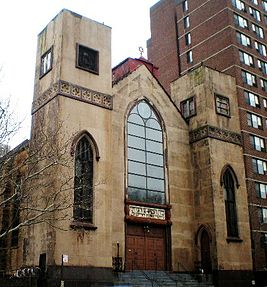When people die, we say kaddish.
When a synagogue perishes, we should say kaddish as well.
Those were my thoughts when I heard of the fiery destruction of the historic Beth Hamedrash Hagodol on New York’s Lower East Side, which occurred last week.
It gets worse.
It now turns out that a teenager has been arrested for arson.
The synagogue dates back to the 1850s, when it was first erected as a Baptist church.
In the 1880s, the building was purchased by the congregation Beth Hamedrash Hagodol, which occupied the space until it closed in 2007 — though the religious community that it housed still exists, and has been in the process of reviving itself.
In 1967, the building became one of New York City’s earliest designated historic landmarks, because of its special historical and aesthetic interest.
The destruction of any house of worship – especially through the willful act of arson – should upset us.
But, there is more.
For me, there is a sad poignancy in this act of destruction.
Because I remember one of that synagogue’s greatest rabbis.
His name was Rabbi Ephraim Oshry.
And, unless you know a lot about the Holocaust and the sacred literature associated with it, you might never have heard of him.
Oshry was born in Kupiskis, Lithuania, and studied at the Slobodka Yeshivah.
During the Nazi occupation of Lithuania, he became the rabbi of the Kaunas (Kovno) ghetto. As part of his duties, he issued responsa — answers to questions concerning Jewish practice.
Here is the amazing thing.
When someone asked him a question, he would write the details on scraps of paper, along with the responses he provided. He then hid these papers in cans, which he then buried in the ground.
After the war, Rabbi Oshry unearthed the hidden cans. He painstakingly reviewed each and every question.
Why?
Because when people had asked him the original questions, he had no access to any of his sacred texts. He issued all of his response — based simply on his prodigious memory.
After the war, Oshry wanted to check his work. He wanted to be sure that his answers were accurate and truly based on Torah texts.
After the war, Oshry went to Rome. There, in 1945, he founded a yeshiva for young Holocaust survivors.
In 1950, he moved the yeshiva to Montreal.
Then, he moved it to New York.
In 1952, he became rabbi of Beth Hamedrash Hagodol.
Sixty-five years later, that shul was in flames.
Why did I admire Rabbi Oshry? And why should you do the same?
Because of the depth, spirituality, and compassion that he offered Jews – in the most extreme moments of Jewish history.
Consider two examples.
A young boy asked Rabbi Oshry: Even though I am some months away from my thirteenth birthday (the age of bar mitzvah), would you let me put on tefilin?
Here is how Oshry began his answer:
When I fathomed the simple sincerity of this boy’s request, tears gushed from my eyes. I could not help citing the words of the prophet Jeremiah: “Who would grant that my head be water, my eyes a source of tears…for death has come up in our windows, has entered our houses, to destroy the youth outside, our chosen ones from the streets.”
This was his response: Yes, the boy could put on tefilin, even though he was below the age of thirteen.
And why?
New edicts by the German taskmasters were issued against us every day; especially upon Jewish children. Who could assure this boy that he would ever reach the age of 13 to fulfill the mitzvah?
This was why the could not, and should not, wait to don tefilin.
Utter wisdom, and utter compassion.
A second question – and much more troubling.
After the war, a husband reunited with his wife, who had been forcibly separated from him. She had been imprisoned in a concentration camp.
The man discovered that his wife now bore a horrible tattoo, that marked her as having been forced into prostitution in an SS brothel.
The man asked Rabbi Oshry: was it permissible for him to resume sexual relations with his wife?
Horrible? Yes. How could the husband have even asked that question?
But, here is how Rabbi Oshry answered the question.
The woman had been raped, and therefore, there was certainly no culpability on her part. A woman’s claim of rape is always to be believed.
But, Oshry went one step further. He said something about the horrible tattoo itself.
There is no need to attempt to efface the tattoo…..on the contrary, it should be viewed not as a sign of shame and disgrace, but rather as a sign of honor and strength. This tattoo is a sign that we shall yet see the destruction of those who lost all semblance of humanity, who were like beasts of the forest and ravening wolves…
Rabbi Oshry understood the meaning of spiritual heroism.
Remember: he made these decisions not based on the texts that he had at his disposal, because he had none.
Rather, he relied on his memory. He did as well as he could under the circumstances.
I just want the punk who torched that synagogue to know who its rabbi had been.
I want that punk to know something of that rabbi’s teachings — a refusal to surrender to hatred and despair.
Maybe that should be his punishment: learn Hebrew; read Oshry’s responsa; translate them.
And learn to live by his words and by his values.






